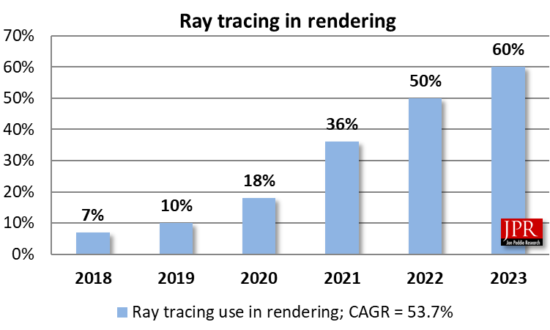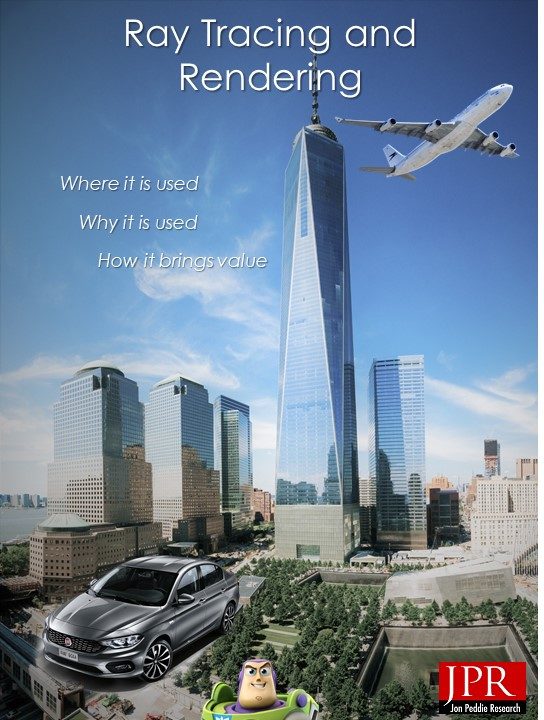The latest ray racing report by Jon Peddie Research discusses the suppliers, the programs, and includes marketing data to help understand the positioning of the many suppliers in the field.
You probably do know ray tracing is the physically accurate photorealistic representation of objects and is used throughout the concept, design, prototyping (including virtual), manufacturing, and marketing phases of most products, and certainly all consumer products, all animations, new cars, buildings, and fashion.
And ray tracing isn’t just about shiny surfaces; there are all types of uses for and styles of ray tracing; one researcher likens it to writing because it can accommodate a wealth of different styles. It is being used more often in more broader industries
You probably do know ray tracing is the physically accurate photorealistic representation of objects and is used throughout the concept, design, prototyping (including virtual), manufacturing, and marketing phases of most products, and certainly all consumer products, all animations, new cars, buildings, and fashion. But, ray tracing isn’t just about shiny surfaces; there are all types of uses for and styles of ray tracing; one researcher likens it to writing because it can accommodate a wealth of different styles. It is being used more often in more broader industries.

Ray tracing is coupled to 3D modeling, uses extensive and complex material libraries, and is linked to physics, game-engines used in simulations, and FEA constructs for the crash and compliance testing.

We estimate the number of users of 3D rendering software to be 2.1 million based on software usage and that number is set to grow given the emergence of new tools, pre-made models, and hardware acceleration. The ray tracing market growth has a CAGR of 5% and should be almost a quarter of a billion dollars in 2023.
Ray tracing is the most essential general-purpose rendering technique available. It is not the only rendering technique, nor is it the fastest, but it is the most accurate and can be the most photorealistic. It is one method within a continuum of methods of rendering a computer-generated image, but it has revolutionized rendering for art, gaming, engineering, and architecture.
As you may have guessed by now, we’ve written a report on ray racing. It’s designed for anyone who wants to learn about the ray tracing market, and it discusses the suppliers, the programs, and the technology. It’s not intended as a tutorial on ray tracing mathematics or physics, or how to use ray tracing software. It includes marketing data to help people interested in the technology understand the positioning of the many suppliers in the field who will affect the way the rendering market will develop in the future. And it includes some historical backgrounding to explain how technology has gotten to this point of being a core piece of the rendering process and as a basis for our predictions of the future of rendering.
Who needs ray tracing? Well I’m biased, but I think everyone in engineering and design. For certain types of design, ray tracing is not desirable but demanded. For example, in the design of optical systems (lens, mirrors, and other components), jewelry design, lighting fixtures, and lamp design. In addition to such physical designs, there is a field of ray tracing for wave and field design in radio and acoustics. In these examples, the design, and resultant images and data must be absolutely physically accurate and photorealistic. The rendering of a surface can reveal problems in the model or highlight an area that needs further refinement for the design.
Rendering and ray tracing software comes in various packages as stand-alone programs, integrated with a 3D modeler, or as a plug-in. A wide range of professions use photorealistic renderings such as architects, product designers, and engineers. Hollywood uses rendering in making CGI blockbusters; video game developers use it for cars and robots, and scientists use it for optics and subterranean exploration. Physically accurate renderings help doctors and radiologists find things that aren’t easily revealed on a simple X-ray or MRI layer.
The use of ray tracing begins with the proposal for a product, bridge, automobile, movie or packaging concept. Used during design and pre-production in virtual prototyping, pre-viz, and concept sign off and, of course, it’s used extensively in marketing.
And by the way, we’ll be conducting three consecutive panels at FMX on the production pipeline, from pitch to product, at FAM in Stuttgart, first week in May. We’ll be announcing speakers soon.





